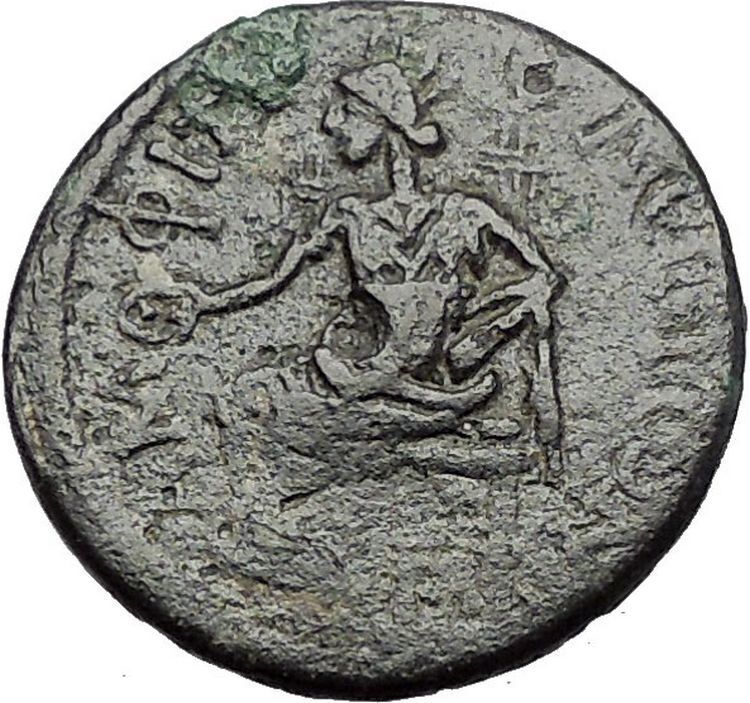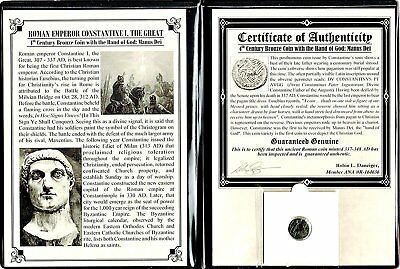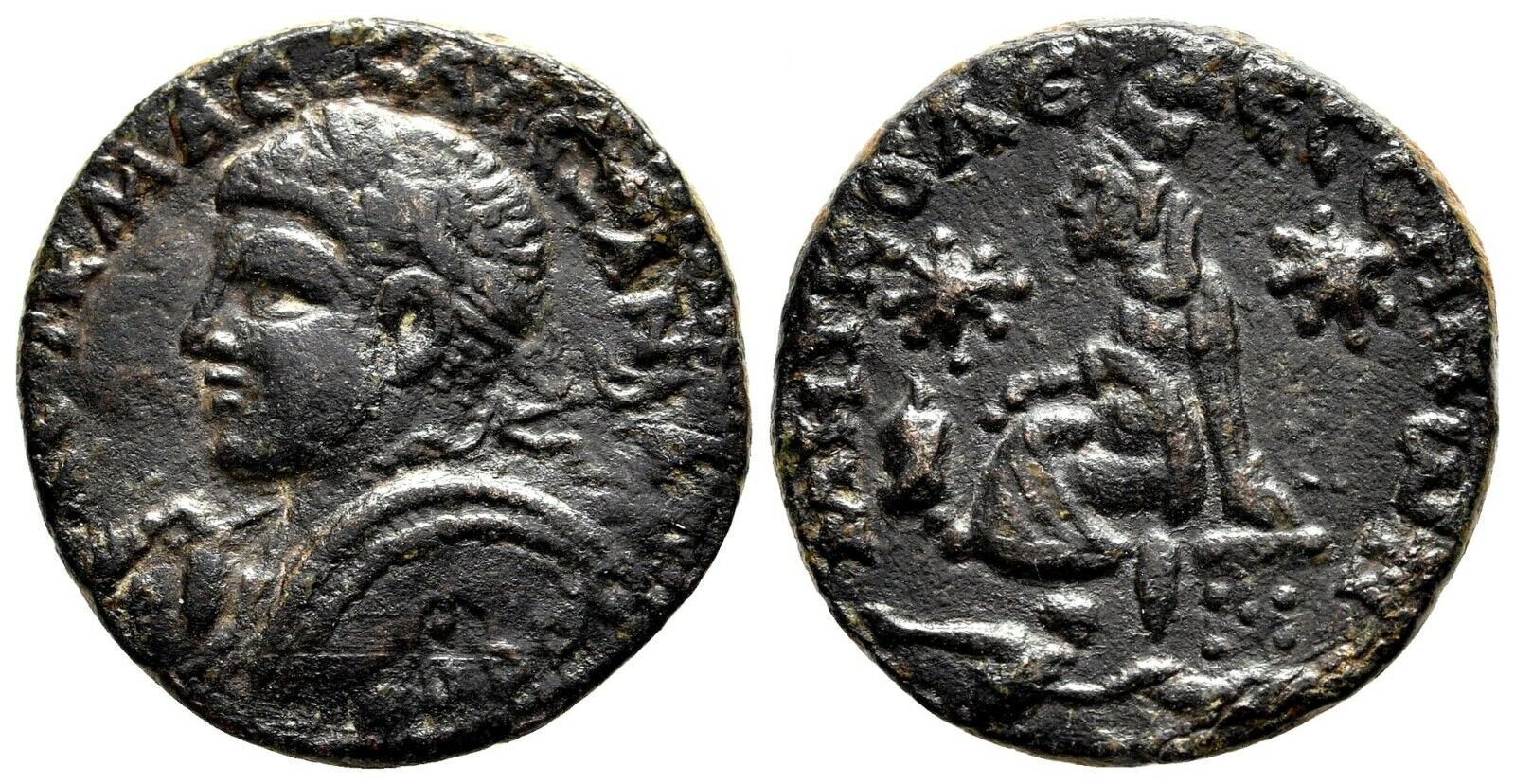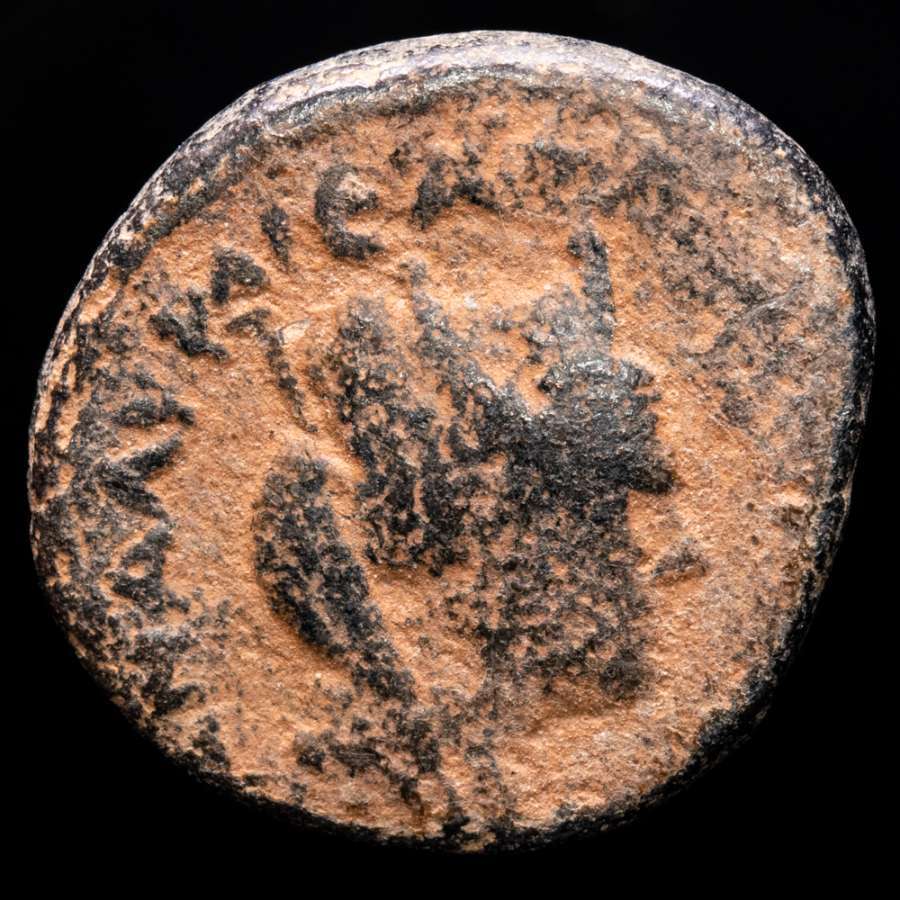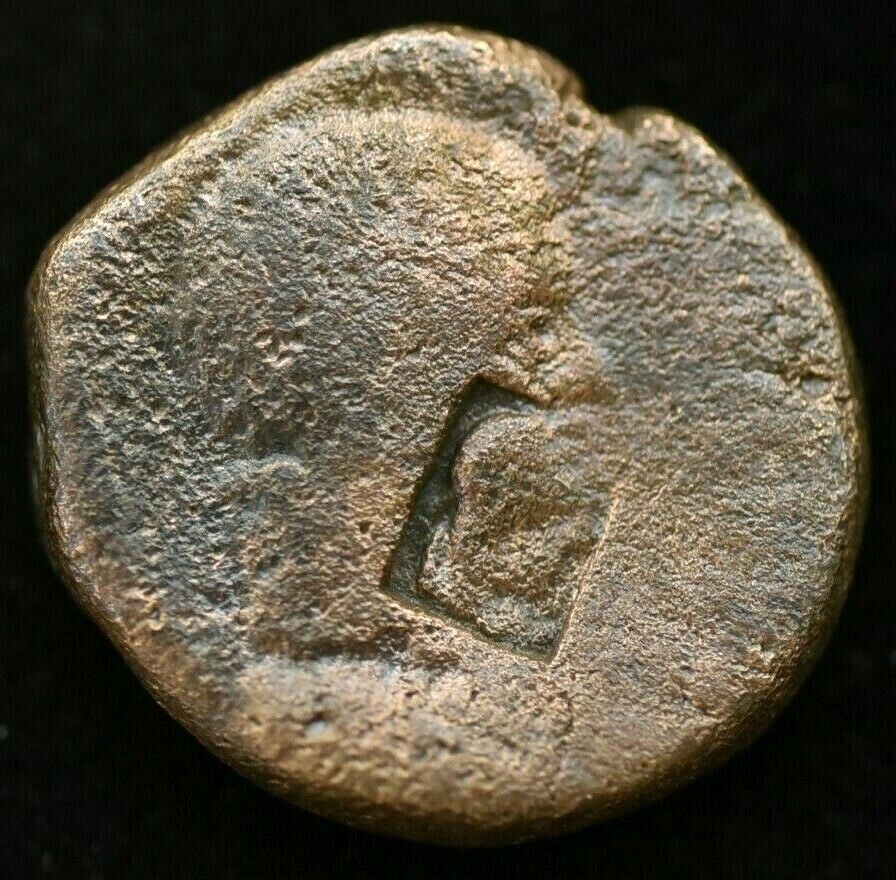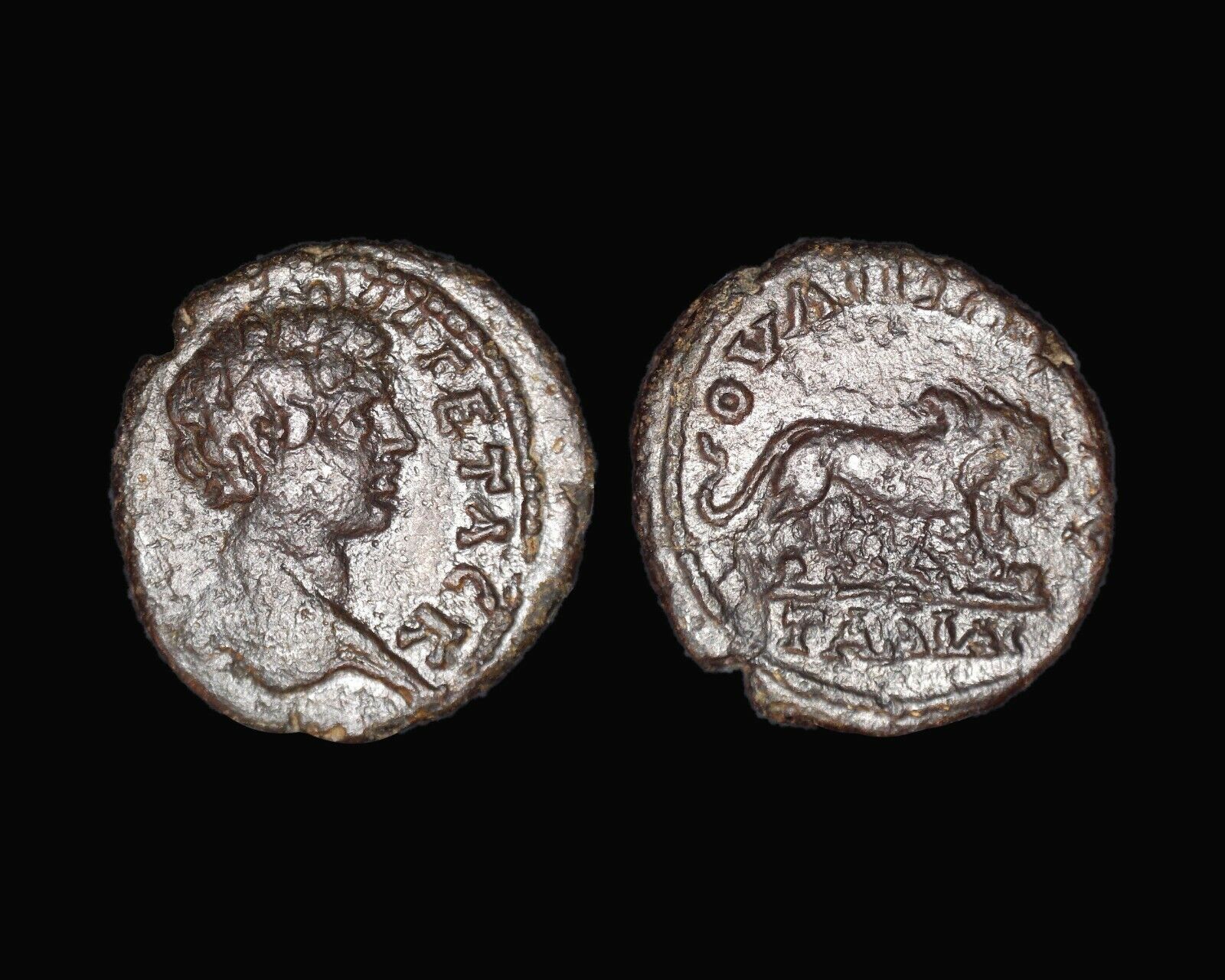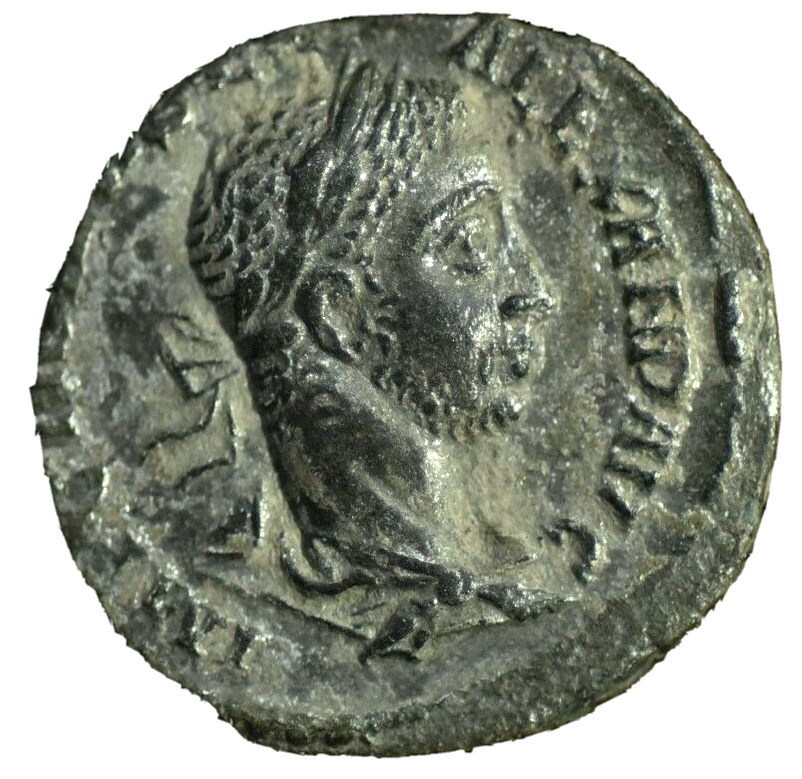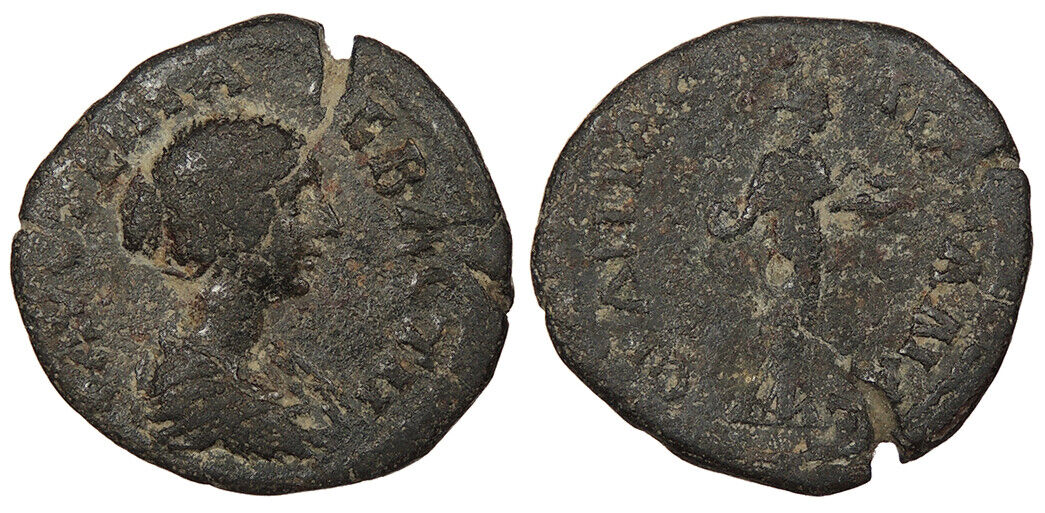-40%
ANTONINUS PIUS 138AD Amphipolis in Macedonia TYCHE Very Rare Roman Coin i55403
$ 63.35
- Description
- Size Guide
Description
Item:i55403
Authentic Ancient Coin of:
Antoninus Pius
-
Roman Emperor
: 138-161 A.D.
Bronze 21mm (5.97 grams) of
Amphipolis
in
Macedonia
Reference: RPC IV online 5018
ΑΥΤΟΚΡΑ ΚΑΙСΑΡ ΑΝΤωΝΙΝOС, Laureate head right, with slight drapery.
ΑΜΦΙΠOΛΙС, Tyche seated left on throne, holding patera and cornucopia.
Very rare
You are bidding on the exact item pictured, provided with a Certificate of Authenticity and Lifetime Guarantee of Authenticity.
Tyche (Greek for luck; the Roman equivalent was
Fortuna
) was the presiding
tutelary deity
that governed the fortune and prosperity of a city, its destiny. Increasingly during the Hellenistic period, cities had their own specific iconic version of Tyche, wearing a
mural crown
(a crown like the walls of the city).
The Greek historian
Polybius
believed that when no cause can be discovered to events such as floods, droughts, frosts or even in politics, then the cause of these events may be fairly attributed to Tyche.
Stylianos Spyridakis concisely expressed Tyche's appeal in a Hellenistic world of arbitrary violence and unmeaning reverses: "In the turbulent years of the
Epigoni of Alexander
, an awareness of the instability of human affairs led people to believe that Tyche, the blind mistress of Fortune, governed mankind with an inconstancy which explained the vicissitudes of the time."
In literature, she might be given various genealogies, as a daughter of
Hermes
and
Aphrodite
, or considered as one of the
Oceanids
, daughters of
Oceanus
and
Tethys
, or of
Zeus
. She was connected with
Nemesis
and
Agathos Daimon
("good spirit").
She was uniquely venerated at
Itanos
in Crete, as
Tyche Protogeneia
, linked with the Athenian
Protogeneia
("firstborn"), daughter of
Erechtheus
, whose self-sacrifice saved the city.
She had temples at
Caesarea Maritima
,
Antioch
,
Alexandria
and
Constantinople
. In
Alexandria
the
Tychaeon
, the temple of Tyche, was described by
Libanius
as one of the most magnificent of the entire Hellenistic world.
Tyche appears on many
coins
of the Hellenistic period in the three centuries before the Christian era, especially from cities in the Aegean. Unpredictable turns of fortune drive the complicated plotlines of
Hellenistic romances
, such as
Leucippe and Clitophon
or
Daphnis and Chloe
. She experienced a resurgence in another era of uneasy change, the final days of publicly sanctioned
Paganism
, between the late-fourth-century emperors
Julian
and
Theodosius I
who definitively closed the temples. The effectiveness of her capricious power even achieved respectability in philosophical circles during that generation, though among poets it was a commonplace to revile her for a fickle harlot.
In
medieval art
, she was depicted as carrying a
cornucopia
, an
emblematic
ship's rudder, and the
wheel of fortune
, or she may stand on the wheel, presiding over the entire circle of fate.
The constellation of
Virgo
is sometimes identified as the heavenly figure of Tyche, as well as other goddesses such as
Demeter
and
Astraea
.
Amphipolis
was an
ancient
Greek
city
in the region once inhabited by the
Edoni
people in the present-day
periphery
of
Central Macedonia
. It was built on a raised plateau overlooking the east bank of the
river
Strymon
where it emerged from Lake Cercinitis, about 3 m. from the
Aegean Sea
. Founded in 437 BC, the city was finally abandoned in the 8th century AD. The present municipality Amfipoli, named after the ancient city, occupies the site. Currently, it is a municipality in the
Serres Prefecture
,
Central Macedonia
with a population of 3,623 (2001 census).
Origins
Archaeology
has uncovered remains at the site dating to approximately 3000 BC. Due to the strategic location of the site it was fortified from very early.
Xerxes I
of Persia
passed during his invasion of Greece of 480 BC and buried alive nine young men and nine maidens as a sacrifice to the river god. Near the later site of Amphipolis
Alexander I
of Macedon
defeated the remains of Xerxes' army in 479 BC.
Throughout the 5th century BC,
Athens
sought to consolidate its control over Thrace, which was strategically important because of its primary materials (the gold and silver of the
Pangaion hills
and the dense forests essential for naval construction), and the sea routes vital for Athens' supply of grain from
Scythia
. After a first unsuccessful attempt at colonisation in 497 BC by the
Miletian
Tyrant
Histiaeus
, the Athenians founded a first colony at Ennea-Hodoi (‘Nine Ways’) in 465, but these first ten thousand colonists were massacred by the
Thracians
. A second attempt took place in 437 BC on the same site under the guidance of
Hagnon
, son of
Nicias
.
The new settlement took the name of Amphipolis (literally, "around the city"), a name which is the subject of much debates about
lexicography
.
Thucydides
claims the name comes from the fact that the Strymon flows "around the city" on two sides; however a note in the
Suda
(also given in the lexicon of
Photius
) offers a different explanation apparently given by
Marsyas
, son of
Periander
: that a large proportion of the population lived "around the city". However, a more probable explanation is the one given by
Julius Pollux
: that the name indicates the vicinity of an
isthmus
. Furthermore, the
Etymologicum Genuinum
gives the following definition: a city of the Athenians or of Thrace, which was once called Nine Routes, (so named) because it is encircled and surrounded by the Strymon river. This description corresponds to the actual site of the city (see adjacent map), and to the description of Thucydides.
Amphipolis subsequently became the main power base of the Athenians in Thrace and, consequently, a target of choice for their
Spartans
adversaries. The Athenian population remained very much in the minority within the city. An Athenian rescue expedition led by strategist (and later historian) Thucydides had to settle for securing
Eion
and could not retake Amphipolis, a failure for which Thucydides was sentenced to exile. A new Athenian force under the command of
Cleon
failed once more in 422 BC during a
battle
at which both
Cleon
and
Brasidas
lost their lives. Brasidas survived long enough to hear of the defeat of the Athenians and was buried at Amphipolis with impressive pomp. From then on he was regarded as the founder of the city and honoured with yearly games and sacrifices. The city itself kept its independence until the reign of the king
Philip II
despite several other Athenian attacks, notably because of the government of
Callistratus
of Aphidnae
.
Conquest by the Romans
In 357 BC, Philip removed the block which Amphipolis presented on the road to Macedonian control over Thrace by conquering the town, which Athens had tried in vain to recover during the previous years. According the historian
Theopompus
, this conquest came to be the object of a secret accord between
Athens
and Philip II, who would return the city in exchange for the fortified town of
Pydna
, but the Macedonian king betrayed the accord, refusing to cede Amphipolis and laying siege to Pydna.
After the conquest by Philip II, the city was not immediately incorporated into the kingdom, and for some time preserved its institutions and a certain degree of autonomy. The border of Macedonia was not moved further east; however, Philip sent a number of Macedonians governors to Amphipolis, and in many respects the city was effectively ‘Macedonianized’. Nomenclature, the calendar and the currency (the
gold stater
, installed by Philip to capitalise on the gold reserves of the Pangaion hills, replaced the Amphipolitan
drachma
) were all replaced by Macedonian equivalents. In the reign of
Alexander
, Amphipolis was an important naval base, and the birthplace of three of the most famous Macedonian
Admirals
:
Nearchus
, Androsthenes
[6]
and
Laomedon
whose burial place is most likely marked by the famous lion of Amphipolis.
Amphipolis became one of the main stops on the Macedonian royal road (as testified by a border stone found between
Philippos
and Amphipolis giving the distance to the latter), and later on the ‘
Via Egnatia
’, the principal
Roman Road
which crossed the southern Balkans. Apart from the ramparts of the low town (see photograph), the gymnasium and a set well-preserved frescoes from a wealthy villa are the only artifacts from this period that remain visible. Though little is known of the layout of the town, modern knowledge of its institutions is in considerably better shape thanks to a rich epigraphic documentation, including a military ordinance of
Philip V
and an
ephebarchic
law from the gymnasium. After the final victory of
Rome
over Macedonia in a
battle
in 168 BC, Amphipolis became the capital one of the four mini-republics, or ‘merides’, which were created by the Romans out of the kingdom of the
Antigonids
which
succeeded
Alexander’s Empire in Macedon. These 'merides' were gradually incorporated into the Roman client state, and later province, of
Thracia
.
Revival in Late Antiquity
During the period of
Late Antiquity
, Amphipolis benefited from the increasing economic prosperity of Macedonia, as is evidenced by the large number of
Christian Churches
that were built. Significantly however, these churches were built within a restricted area of the town, sheltered by the walls of the
acropolis
. This has been taken as evidence that the large fortified perimeter of the ancient town was no longer defendable, and that the population of the city had considerably diminished.
Nevertheless, the number, size and quality of the churches constructed between the fifth and sixth centuries are impressive. Four
basilicas
adorned with rich
mosaic
floors and elaborate architectural sculptures (such as the ram-headed
column
capitals - see picture) have been excavated, as well as a church with a hexagonal central plan which evokes that of the
basilica
of
St. Vitalis
in
Ravenna
. It is difficult to find reasons for such municipal extravagance in such a small town. One possible explanation provided by the historian
André Boulanger
is that an increasing ‘willingness’ on the part of the wealthy upper classes in the late Roman period to spend money on local
gentrification
projects (which he terms ‘'
évergétisme
’', from the Greek verb εύεργετέω,(meaning ‘I do good’) was exploited by the local church to its advantage, which led to a mass gentrification of the urban centre and of the agricultural riches of the city’s territory. Amphipolis was also a
diocese
under the
suffragan
of
Thessaloniki
- the Bishop of Amphipolis is first mentioned in 533 AD.
From the reduction of the urban area to the disappearance of the city
The
Slavic invasions
of the late 6th century gradually encroached on the back-country Amphipolitan lifestyle and led to the decline of the town, during which period its inhabitants retreated to the area around the acropolis. The ramparts were maintained to a certain extent, thanks to materials plundered from the monuments of the lower city, and the large unused cisterns of the upper city were occupied by small houses and the workshops of artisans. Around the middle of the 7th century AD, a further reduction of the inhabited area of the city was followed by an increase in the fortification of the town, with the construction of a new rampart with pentagonal towers cutting through the middle of the remaining monuments. The acropolis, the
Roman baths
, and especially the Episcopal basilica were crossed by this wall.
The city was probably abandoned in the eighth century, as the last bishop was attested in 787. Its inhabitants probably moved to the neighbouring site of ancient
Eion
, port of Amphipolis, which had been rebuilt and refortified in the
Byzantine period
under the name “
Chrysopolis
”. This small port continued to enjoy some prosperity, before being abandoned during the
Ottoman period
. The last recorded sign of activity in the region of Amphipolis was the construction of a fortified tower to the north in 1367 by
Grand Primicier
Jean and the
Stratopedarque
Alexis to protect the land that they had given to the monastery of Pantokrator on
Mount Athos
.
Archaeology
The site was rediscovered and described by many travellers and archaeologists during the 19th century, including E. Cousinéry (1831) (engraver), L. Heuzey (1861), and P. Perdrizet (1894–1899). In 1934, M. Feyel, of the
École française d'Athènes
, led an
epigraphical mission
to the site and uncovered the remains of a funeral lion (a reconstruction was given in the, a publication of the EfA which is available on line). However, excavations did not truly begin until after the Second World War. The
Greek Archaeological Society
under D. Lazaridis excavated in 1972 and 1985, uncovering a necropolis, the rampart of the old town (see photograph), the basilicas, and the acropolis.
Amphipolitans
Demetrius of Amphipolis
, student of Plato's
Zoilus
(400 BC-320 BC), grammarian, cynic philosopher
Pamphilus (painter)
, head of
Sicyonian
school and teacher of
Apelles
Aetion
, sculptor
Philippus of Amphipolis
, historian
Nearchus
, admiral
Erigyius
, general
Damasias
[
disambiguation needed
]
of Amphipolis 320 BC
Stadion
Olympics
Hermagoras of Amphipolis
(c. 225 BC), stoic philosopher ,follower of
Persaeus
Xena
, the Warrior Princess of Amphipolis.
Titus Aurelius Fulvus Boionius Arrius Antoninus
(19 September 86 – 7 March 161), generally known in English as
Antoninus Pius
was
Roman emperor
from 138 to 161. He was the fourth of the
Five Good Emperors
and a member of the
Aurelii
. He did not possess the
sobriquet
"
Pius
" until after his accession to the throne. Almost certainly, he earned the name "Pius" because he compelled the
Senate
to deify his adoptive father
Hadrian
; the
Historia Augusta
, however, suggests that he may have earned the name by saving senators sentenced to death by Hadrian in his later years.
//
He was the son and only child of
Titus Aurelius Fulvus
,
consul
in 89 whose family came from
Nemausus
(modern
Nîmes
) and was born near
Lanuvium
and his mother was Arria Fadilla. Antoninus’ father and paternal grandfather died when he was young and he was raised by
Gnaeus Arrius Antoninus
, his maternal grandfather, a man of integrity and culture and a friend of
Pliny the Younger
. His mother married to Publius Julius Lupus (a man of consular rank),
Suffect Consul
in 98, and bore him a daughter called Julia Fadilla.
As a private citizen between 110 and 115, he married Annia Galeria
Faustina the Elder
. They had a very happy marriage. She was the daughter of consul
Marcus Annius Verus
and
Rupilia
Faustina (a half-sister to Roman Empress
Vibia Sabina
). Faustina was a beautiful woman, renowned for her wisdom. She spent her whole life caring for the poor and assisting the most disadvantaged Romans.
Having filled with more than usual success the offices of
quaestor
and
praetor
, he obtained the consulship in 120; he was next appointed by the Emperor
Hadrian
as one of the four
proconsuls
to administer
Italia
, then greatly increased his reputation by his conduct as
proconsul
of
Asia
. He acquired much favor with the Emperor Hadrian, who adopted him as his son and successor on 25 February, 138, after the death of his first adopted son
Lucius Aelius
, on the condition that Antoninus would in turn adopt Marcus Annius Verus, the son of his wife's brother, and Lucius, son of Aelius Verus, who afterwards became the emperors
Marcus Aurelius
and
Lucius Verus
(colleague of Marcus Aurelius).
Emperor
On his accession, Antoninus' name became "Imperator Caesar Titus Aelius Hadrianus Antoninus Augustus Pontifex Maximus". One of his first acts as Emperor was to persuade the
Senate
to grant divine honours to Hadrian, which they had at first refused; his efforts to persuade the Senate to grant these honours is the most likely reason given for his title of
Pius
(dutiful in affection; compare
pietas
). Two other reasons for this title are that he would support his aged father-in-law with his hand at Senate meetings, and that he had saved those men that Hadrian, during his period of ill-health, had condemned to death. He built temples, theaters, and mausoleums, promoted the arts and sciences, and bestowed honours and financial rewards upon the teachers of
rhetoric
and
philosophy
.
In marked contrast to his predecessors
Trajan
and
Hadrian
, Antoninus was not a military man. One modern scholar has written "It is almost certain not only that at no time in his life did he ever see, let alone command, a Roman army, but that, throughout the twenty-three years of his reign, he never went within five hundred miles of a legion".
[2]
His reign was the most peaceful in the entire history of the
Principate
; while there were several military disturbances throughout the Empire in his time, in
Mauretania
,
Iudaea
, and amongst the
Brigantes
in
Britannia
, none of them are considered serious. The unrest in Britannia is believed to have led to the construction of the
Antonine Wall
from the
Firth of Forth
to the
Firth of Clyde
, although it was soon abandoned. He was virtually unique among emperors in that he dealt with these crises without leaving Italy once during his reign, but instead dealt with provincial matters of war and peace through their governors or through imperial letters to the cities such as Ephesus (of which some were publicly displayed). This style of government was highly praised by his contemporaries and by later generations.
Of the public transactions of this period we have scant information, but, to judge by what we possess, those twenty-two years were not remarkably eventful in comparison to those before and after his; the surviving evidence is not complete enough to determine whether we should interpret, with older scholars, that he wisely curtailed the activities of the Roman Empire to a careful minimum, or perhaps that he was uninterested in events away from Rome and
Italy
and his inaction contributed to the pressing troubles that faced not only Marcus Aurelius but also the emperors of the third century. German historian Ernst Kornemann has had it in his Römische Geschichte [2 vols., ed. by H. Bengtson, Stuttgart 1954] that the reign of Antoninus comprised "a succession of grossly wasted opportunities," given the upheavals that were to come. There is more to this argument, given that the Parthians in the East were themselves soon to make no small amount of mischief after Antoninus' passing. Kornemann's brief is that Antoninus might have waged preventive wars to head off these outsiders.
Scholars place Antoninus Pius as the leading candidate for fulfilling the role as a friend of Rabbi
Judah the Prince
. According to the
Talmud
(Avodah Zarah 10a-b), Rabbi Judah was very wealthy and greatly revered in Rome. He had a close friendship with "Antoninus", possibly Antoninus Pius, who would consult Rabbi Judah on various worldly and spiritual matters.
After the longest reign since Augustus (surpassing
Tiberius
by a couple of months), Antoninus died of fever at
Lorium
in
Etruria
, about twelve miles (19 km) from Rome, on 7 March 161, giving the keynote to his life in the last word that he uttered when the
tribune
of the night-watch came to ask the password—"aequanimitas" (equanimity). His body was placed in
Hadrian's mausoleum
, a
column
was dedicated to him on the
Campus Martius
, and the
temple
he had built in the Forum in 141 to his deified wife Faustina was rededicated to the deified Faustina and the deified Antoninus.
Historiography
The only account of his life handed down to us is that of the
Augustan History
, an unreliable and mostly fabricated work. Antoninus is unique among Roman emperors in that he has no other biographies. Historians have therefore turned to public records for what details we know.
In later scholarship
Antoninus in many ways was the ideal of the landed gentleman praised not only by ancient Romans, but also by later scholars of classical history, such as
Edward Gibbon
or the author of the article on Antoninus Pius in the ninth edition of the Encyclopedia Britannicaca:
A few months afterwards, on Hadrian's death, he was enthusiastically welcomed to the throne by the Roman people, who, for once, were not disappointed in their anticipation of a happy reign. For Antoninus came to his new office with simple tastes, kindly disposition, extensive experience, a well-trained intelligence and the sincerest desire for the welfare of his subjects. Instead of plundering to support his prodigality, he emptied his private treasury to assist distressed provinces and cities, and everywhere exercised rigid economy (hence the nickname κυμινοπριστης "cummin-splitter"). Instead of exaggerating into treason whatever was susceptible of unfavorable interpretation, he spurned the very conspiracies that were formed against him into opportunities for demonstrating his clemency. Instead of stirring up persecution against the Christians, he extended to them the strong hand of his protection throughout the empire. Rather than give occasion to that oppression which he regarded as inseparable from an emperor's progress through his dominions, he was content to spend all the years of his reign in Rome, or its neighborhood.
Frequently Asked d Questions
How long until my order is shipped?
Depending on the volume of sales, it may take up to 5 business days for shipment of your order after the receipt of payment.
How will I know when the order was shipped?
After your order has shipped, you will be left positive feedback, and that date should be used as a basis of estimating an arrival date.
After you shipped the order, how long will the mail take?
USPS First Class mail takes about 3-5 business days to arrive in the U.S., international shipping times cannot be estimated as they vary from country to country. I am not responsible for any USPS delivery delays, especially for an international package.
What is a certificate of authenticity and what guarantees do you give that the item is authentic?
Each of the items sold here, is provided with a Certificate of Authenticity, and a Lifetime Guarantee of Authenticity, issued by a world-renowned numismatic and antique expert that has identified over 10000 ancient coins and has provided them with the same guarantee. You will be quite happy with what you get with the COA; a professional presentation of the coin, with all of the relevant information and a picture of the coin you saw in the listing.
Compared to other certification companies, the certificate of authenticity is a -50 value. So buy a coin today and own a piece of history, guaranteed.
Is there a money back guarantee?
I offer a 30 day unconditional money back guarantee. I stand behind my coins and would be willing to exchange your order for either store credit towards other coins, or refund, minus shipping expenses, within 30 days from the receipt of your order. My goal is to have the returning customers for a lifetime, and I am so sure in my coins, their authenticity, numismatic value and beauty, I can offer such a guarantee.
Is there a number I can call you with questions about my order?
You can contact me directly via ask seller a question and request my telephone number, or go to my About Me Page to get my contact information only in regards to items purchased on eBay.
When should I leave feedback?
Once you receive your order, please leave a positive. Please don't leave any negative feedbacks, as it happens many times that people rush to leave feedback before letting sufficient time for the order to arrive. Also, if you sent an email, make sure to check for my reply in your messages before claiming that you didn't receive a response. The matter of fact is that any issues can be resolved, as reputation is most important to me. My goal is to provide superior products and quality of service.
